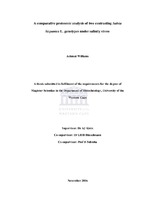| dc.description.abstract | Salvia hispanica L. is an annual pseudocereal food crop, locally known as chia that has the ability to grow in water stress environments. The importance of chia dates back to the pre-columbian era where it was consumed as staple food by the indigenous South Americans due to its high nutritional and medicinal benefits. A single chia plant produces two seed variants: white seed genotype (denoted as WSG) and black seed genotype (denoted as BSG). Chia seeds have been proven to have a huge potential as a healthy food source and contained various medicinal properties. However, these plants are still prone to environmental stress conditions such as salinity that is one of the major abiotic stresses that influence crop production and yield worldwide. Despite the nutritional impact of the chia seeds, limited information regarding their molecular responses to abiotic stress conditions are known. This study was divided into two distinct parts. Firstly, the study comparatively analysed the leaf proteomes of two chia genotypes using gelbased proteomic analysis coupled with mass spectrometry. Total soluble proteins were extracted from chia leaves and subjected to 2-D PAGE analysis. Proteins were visualized by CBB and identified by MALDI-TOF MS/MS. A total of 284 and 209 spots were detected in WSG and BSG, respectively. Using mass spectrometry, 36 differentially expressed protein spots were successfully identified based on their protein abundance using homology database searches. Interestingly, two defensive-related proteins (osmotin-like protein and the chalcone isomerase) were only present in WSG and absent in BSG. In light of
previous information regarding the nutritional profiles (no significant difference) of these two genotypes, this study has shown that there are distinct molecular differences between these genotypes. Therefore, WSG will be used in further downstream analysis. The second part of this study focused on the influence of salt stress (imposed by 100 mM NaCl) on the leaf proteome of WSG. Using gel-based proteomic
analysis, 61 differentially expressed proteins were identified and classified into nine functional categories. Most of the proteins identified in this study were upregulated by salt stress. Interesting to note, 12 proteins identified in this study were only present in response to salt stress but were absent in the control. These proteins include ATP-dependent zinc metalloprotease FTSH 2 (spot 48), HSP70 proteins (spots 46 and 47), superoxide dismutases (spots 10, 41 and 42) and an ascorbate peroxidase (spot 56). All these proteins are important antioxidants that
play a significant role in scavenging reactive oxygen species (ROS). Previous studies have shown that these antioxidants play vital roles in stress tolerance. These proteins could serve as potential biomarkers that could be used to enhance salt stress tolerance in pseudocereals and cereal food crops. | en_US |

